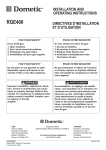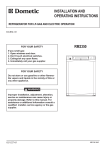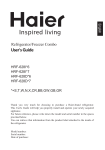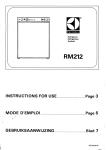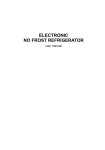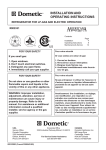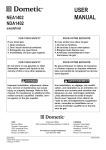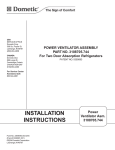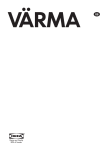Download Dometic NEA1402 Operating instructions
Transcript
® INSTALLATION AND OPERATING INSTRUCTIONS REFRIGERATOR FOR LP-GAS AND ELECTRIC OPERATION NDA1402 autodefrost Contents: Installation Operating Instructions Icemaker Maintenance & Service FOR YOUR SAFETY Page 5 9 15 16 Pour votre sécurité If you smell gas: Si vous sentez une odeur de gaz: 1. Open windows. 2. Don’t touch electrical switches. 3. Extinguish any open flame. 4. Immediately call your gas supplier. 1. Ouvrez les fenêtres. 2. Ne touchez à aucun interrupteur. 3. Éteignez toute flamme nue. 4. Avertissez immédiatement votre fournisseur de gaz. Pour votre sécurité FOR YOUR SAFETY Do not store or use gasoline or other flammable vapors and liquids in the vicinity of this or any other appliance. Ne pas entreposer ni utiliser de l’essence ni d’autres vapeurs ou liquides inflammables à proximité de cet appareil ou de tout autre appareil. WARNING: Improper installation, adjustment, alteration, service or maintenance can cause injury or property damage. Refer to this manual. For assistance or additional information consult a qualified installer, service agency or the gas supplier. Avertissement: Une installation, un réglage, une modification, une réparation ou un entretien non conforme aux normes peut entraîner des blessures ou des dommages matériels. Lisez attentivement le mode d’emploi fourni avec l’appareil. Pour obtenir de l’aide ou des renseignements supplémentaires, consultez un installateur ou un service d’entretien qualifié ou le fournisseur de gaz. ® USA Service Office Dometic Corporation 2320 Industrial Pkwy. Elkhart, IN 46516 Phone: 574-294-2511 Corporate Office 2320 Industrial Parkway Elkhart, IN 46515 For Service Center Assistance Call: 800-544-4881 Form No. 825123401 MO-FO 0513 (French 3309981.003) ©2005 Dometic Corporation Lagrange, IN 46761 CANADA Dometic Distribution Inc. 866 Langs Drive Cambridge, Ontario N3H 2N7 Canada Phone: 519-653-4390 NDA 1402 Rear view equipment used for text reference Heaters Flexible cord Refrigerator 12V DC Burner control Protection cover Power module and fuses Flue baffle 12V DC 12V DC Thermofuse Burner jet FIG. 1 Drain water hose Manual gas shut off valve Heating cabel Inlet fitting Thermostat Water hose Ice maker Water solenoid valve Flexible cord Ice maker GENERAL INSTRUCTION This appliance is designed for storage of foods and storage of frozen foods and making ice. This appliance is certified under the latest edition of ANSI Z21.19•CSA 1.4 Refrigerators using gas fuel. The installation must conform with local codes, or in absence of local codes, the following standards as applicable. 12 Volt DC Terminal block In CANADA, the installation must conform with: 1. Natural Gas and Propane Installation Code, CSA B149.1 2. CSA Z240 RV Series, Recreational Vehicles. 3. Current CSA Z240.4, Gas-equipped Recreational Vehicles and Mobile Housing. If an external electrical source is utilized, the refrigerator, when installed, must be electrically grounded in accordance with local codes or, in the absence of local codes, the Canadian Electrical Code, CSA C22.1, Parts I and II - (latest edition). In the U.S. the installation must conform with: 1. National Fuel Gas Code, ANSI Z223.1/NFPA 54 (latest edition). 2. Recreational Vehicles Code, ANSI A119.2 (latest edition) 3. Manufactured Home Construction and Safety Standard, Title 24 CFR, Part 3280. If an external electrical source is utilized, the refrigerator, when installed, must be electrically grounded in accordance with local codes or, in the absence of local codes, the National Electrical Code, ANSI/NFPA 70 - (latest edition). 3 Refrigerator control panel 1 2 3 4 LEGEND 2-WAY Model Panel Controls: 1. Main Power ON/OFF key 2. AUTO/STORE key/ Combined energy mode selection and store key PM AUTO AC GAS FREEZER FRIDGE 3. LED Display Panel The LED panel displays preferably temperatures in the refrigerator and current modes of operation. However, also other useful status messages are displayed. Note: The displayed temperature values reflect the storage temperatures of the food in the two compartments. A delay function prevents rapid changes due to door openings etc. Panel Indications: FIG. 2 • • • • • • • • Actual temperature of food in frozen food compartment Actual temperature of food in fresh food compartment AUTO mode indication AC operation indication GAS operation indication Thermostat setting indication (temporary during setting) Real time clock/ PM indication (temporary during setting) Various status and error messages 4. SET key/ Combined temperature range and real time clock adjustment. Store function: When setting the real time clock as well as the thermostat, the desired setting can be stored by either, automatically after 5 sec. of inactivity or by pressing the STORE key. 4 INSTALLATION VENTILATION The installation shall be made in such a manner as to separate the combustion system from the living space of the mobile home or recreational vehicle. Openings for air supply or for venting of combustion products shall have a minimum dimension of not less than 1/4 inch. The free length of the cord is 2 feet and therefore recommended that the receptacle be located to the right side (opposite side of refrigerator burner assembly) of the refrigerator (viewed from the rear). The receptacle should be 3” (from the bottom of the plastic receptacle) above the refrigerator mounting floor. (see FIG. 3). This allows easy access through the vent door. The cord should be routed to avoid direct contact with the burner cover, flue cover or any other components that could damage the cord insulation. Proper installation requires one lower fresh air intake and one upper exhaust vent. The ventilation kits shown in this instruction manual have been certified for use with the refrigerator models listed in the table. For “Certified Vent System Kits” see page 19. The ventilation kits must be installed and used without modification. An opening toward the outside at floor level in the refrigerator compartment must be provided for ventilation of heavier-than-air fuel gases. The lower vent of the recommended kits is provided with proper size openings. The flow of combustion and ventilating air must not be obstructed. The lower side vent is fitted with a panel, which provides an adequate access opening for ready serviceability of the burner and control manifold of the refrigerator. This should be centered on the back of the refrigerator. 120 Volt AC receptacle 3’’ FIG. 3 GAS CONNECTION Hook up to the gas supply line is accomplished at the manual gas valve, which is furnished with a 3/8" SAE (UNF 5/8" -18) male flare connection. All completed connections should be checked for leaks with soapy water. ! WARNING DO NOT use a flame to check for gas leaks. The gas supply system must incorporate a pressure regulator to maintain a supply pressure of not more than 11 inches water column. When testing the gas supply system at test pressures in excess of 1/2 psi, the refrigerator and its individual shut off valve must be disconnected from the gas supply piping system. When testing the gas supply system at pressures less than or equal to 1/2 psi, the appliance must be isolated from the gas supply piping system by closing its individual manual shut off valve. In case detailed instructions on the installation and connection to the gas supply are required, contact your dealer or distributor. ELECTRICAL CONNECTION 12 Volts DC Connection The refrigerator model NDA 1402 require a continuous 12 volt DC supply to maintain the automatic energy selector system and the auto defrost control system to function. The connection is made to the positive (+) and negative (-) terminals of the terminal block on the back of the refrigerator. (See FIG. 1). Correct polarity must be observed when connecting to the DC supply. Do not use the chassis or vehicle frame as one of the conductors. Connect two wires at the refrigerator and route to the DC supply. It is important that the wires to the 12-volt DC terminal is of proper wire size. Recommended conductor wires size and total conductor wires length are found in the table below. Length <33 ft. (<10m) 33 - 66 ft. (10 - 20m) >66 ft. (>20m) Minimum Wire Size 12 AWG 10 AWG 8 AWG 120 Volts AC Connection The refrigerator is equipped with a three-prong (grounding) plug for your protection against shock hazards and should be plugged directly into a properly grounded threeprong receptacle. DO NOT cut or remove the grounding prong from this plug. Example: If the distance between the refrigerator and the 12V DC supply is 20 ft., the total wire length is 40 ft. and a wire size of 10 AWG should be used. 5 INSTALLING REFRIGERATOR IN ENCLOSURE FIG. 4 The transport support at the rear of the refrigerator can be removed if necessary for the installation of the refrigerator in the enclosure. (See figure above). NOTE: DO NOT install the appliance directly on carpeting. Carpeting must be removed or protected by a metal or wood panel beneath the appliance, which extends at least full width and depth of the appliance. Caution: Use care when installing the refrigerator. This refrigerator is equipped with the latest vacuum insulated panel technology. These insulating panels are located on the Top, Back, Bottom, Sides and Doors of the refrigerator. If the surface is punctured, loss of insulation will occur, resulting in poor refrigerator performance. NOTE: A wood strip must be in place across the upper opening of the enclosure. The top frame of the refrigerator will be anchored to the wood strip with screws, see FIG. 10. The refrigerator must be installed in a substantial enclosure and must be level. When installing the refrigerator in the enclosure, all areas within the recess in which the refrigerator is installed must be sealed. Make sure that there is a complete seal between the front frame of the refrigerator and the top, sides and bottom of the enclosure. A length of sealing strip is applied to the rear surface of the front frame for this purpose, see FIG. 4. The sealing should provide a complete isolation of the appliance’s combustion system from the vehicle interior. NOTE: Be careful not to damage the sealing strip when the refrigerator is put in place. Securing the Refrigerator After the refrigerator is put in place, (ensuring a combustion seal at the front frame), the refrigerator is to be secured in the enclosure with six screws (not included). The screws have to be installed in the following order: STEP 1: Two screws installed through the front base, which includes the lower front strip installation. The refrigerator is provided with a lower front strip (shipped as a loose part). The front strip is to be attached after the refrigerator is set into the cutout opening. 1. Install the lower front strip by sliding it under the bottom hinge plates, as shown in FIG. 5. FIG. 5 FIG. 6 2. Secure the refrigerator and the lower front strip with two screws: One screw through each hinge. See FIG 6. 6 Step 2: Two screws installed in the top frame. Open the doors and fasten the refrigerator with two screws through the holes underneath the top decoration panel. See FIG. 7. FIG. 7 STEP 3: Two screws installed in the rear base. See FIG. 8. FIG. 8 TESTING LP GAS SAFETY SHUT OFF The gas safety shut off must be tested after the refrigerator is connected to LP gas supply. To test the gas safety shut off, proceed as follows: 1. Start the refrigerator according to the instructions, and switch to GAS mode. (See start up instructions “Select energy mode of operation”). 2. Check that the dot for GAS mode on the LED is on, check that the gas flame is lit. 3. Close the manual gas shut off valve at the back of the refrigerator. (See FIG. 1). 4. Wait until “ch LP” is flashing on the LED panel approximately 6 to 7 minutes. 5. Remove protection cover (see FIG. 1) and open the manual gas shut off valve. Do not change any button positions on the control panel. Apply a noncorrosive commercial bubble solution to the burner jet orifice. 6. No bubbles should appear at the opening of the burner jet orifice. The presence of bubbles indicates a defective gas safety shut off, and service is required. 7. If no bubbles were present at the burner jet orifice, it should be rinsed with fresh water. Be careful not to damage the burner jet orifice. Replace cover and press the main power ON/OFF button (1) OFF and back ON. Normal operation of the burner should return. Allow the burner to operate for a minimum of five minutes. Hole for drain water hose Failure to follow the sequence in securing refrigerator in enclosure can cause leakage between the frame and cabinet. Any space between the counter, storage area or ceiling and top of the refrigerator greater den 1-1/2 inches should be blocked. The heat produced at the rear of the refrigerator will become trapped in this space, making the top of the refrigerator hot and reduce the efficiency of the refrigerator. Drain water hose A hole must be drilled through flooring see FIG. 8. The hole must be drilled in the cut out opening of the base plate at the rear of the refrigerator. The installer MUST make sure that the hose does not kink when run through the floor. Seal around the hose that goes through the drilled hole. If a longer hose than supplied is required to get the water to drain outside of the vehicle, the installer will have to supply the extra length of hose. 7 CERTIFIED INSTALLATION METHODS OF INSTALLATION Certified installations require one roof vent and one lower side vent. For “Certified Vent System Kits” see page 19. For further information contact your dealer or distributor. The method of installation is shown in FIG. 9. It is essential that all maximum or minimum dimensions are strictly maintained as the performance of the refrigerator is dependent on adequate flow of air over the rear of the refrigerator. NOTE: The upper vent should be centered over the condenser coil at the back of the refrigerator. VENTILATION HEIGHTS Ventilation height Installation with roof vent and lower side vent Minimum ventilation heights in: Refrigerator Inches mm NDA 1402 69-1/8 1756 Condenser CLEARANCES Minimum clearances in inches to combustible materials are: G: K: L: M: N: Top 0 Side 0 Bottom 0 Rear 0 See NOTE: Clearance “N” below. NOTE: Clearance “M” is between the rearmost part of the refrigerator and the wall behind the refrigerator. FIG. 9 LOWER VENT CUTOUT NOTE: Clearance “N” is the distance between the bottom of the lower vent to the roof material. For ventilation height, see table VENTILATION HEIGHTS See Figures 9, and 10. 13-5/8” 28-5/8” NOTE: Wood Strip MUST be in place G N K K L FIG. 10 8 M Side view View from above FIG. 11 C D D H A Overall Dimensions Refrigerator Model Height Width A B inch 64-17/64 33-11/16 W B Recess Dimensions Depth C 29-5/8 Height H 63-3/16 Width W 32-3/4 752 1605 832 Depth D 26-1/16 NDA 1402 mm 1632 855 662 This method of installation and these clearances will give you adequate space for service and proper installation. OPERATING INSTRUCTIONS IMPORTANCE OF LEVELING A REFRIGERATOR In an absorption refrigerator system, ammonia is liquefied in the finned condenser coil at the top rear of the refrigerator. The liquid ammonia then flows into the evaporator (inside the freezer section) and is exposed to a circulating flow of hydrogen gas, which causes the ammonia to evaporate, creating a cold condition in the freezer. When starting this refrigerator for the very first time, the cooling cycle may require up to four hours of running time before the cooling unit is fully operational. The tubing in the evaporator section is specifically sloped to provide a continuous movement of liquid ammonia, flowing downward by gravity through this section. If the refrigerator is operated when it is not level and the vehicle is not moving, liquid ammonia will accumulate in sections of the evaporator tubing. This will slow the circulation of hydrogen and ammonia gas, or in severe cases, completely block it, resulting in a loss of cooling. Any time the vehicle is parked for several hours with the refrigerator operating, the vehicle should be leveled to prevent this loss of cooling. The vehicle needs to be leveled only so it is comfortable to live in (no noticeable sloping of floor or walls). When the vehicle is moving, the leveling is not critical, as the rolling and pitching movement of the vehicle will pass to either side of level, keeping the liquid ammonia from accumulating in the evaporator tubing. OPERATION Before starting the refrigerator, check that all the manual gas valves are in the ON position. DO NOT forget the manual shut off valve on the rear of the refrigerator see FIG. 1. This refrigerator is equipped with an automatic energy selector system and an auto defrosting control system. The energy selector system will automatically select the most suitable energy source that is available, either 120-volt AC, or LP gas operation. The system can be set by the user to be fully automatic, or if desired, LP gas only. The defrost system will automatically carry out defrost in frozen food and fresh food compartment once per 24 hours. To be able to control the performance of the defrost intervals the system is equipped with a built in real time clock. The clock has to be set to local time at the very first start up of the refrigerator or when the 12-volt DC supply has been disconnected for a longer period of time. A message on the LED panel will alert when the clock needs to be set. ! WARNING Most LP gas appliances used in recreational vehicles are vented to the outside of the vehicle. When parked close to a gasoline pump, it is possible that the gasoline fumes could enter this type of appliance and ignite from the burner flame, CAUSING A FIRE OR AN EXPLOSION. FOR YOUR SAFETY, when refueling, shut off all LP gas appliances which are vented to the outside. 9 START UP INSTRUCTIONS 1. Press the main power ON/OFF key. If the real time clock has to be set the LED panel will show flashing horizontal bars ” -- -- “. Set real time clock PM INDICATION HOURS MINUTES 1. To enter TIME MODE keep SET key pressed until figures flash on the LED panel. Hours are to the left and minutes to the right. 2. Press SET key to adjust to local time. PM or not should also be set here. 3. Store each setting by pressing AUTO/STORE key or use the automatic store function (wait 5 sec.). Set thermostat range 1. Press SET key to desired thermostat range, 1 to 5 where 5 represent the coldest compartment temperature. 2. Store by pressing AUTO/STORE key or use the automatic store function (wait 5 sec.). Select energy mode of operation 1. Press AUTO/STORE key to select Auto mode operation or locked up to LP-gas mode operation only. Current mode of operation and energy source, AC or GAS is indicated by a dot on the LED panel. 10 Status message Status message Message displayed Steady display Alternating between temperatures and message Defrosting is just now performed ”dE Fr” X Thermostat range setting indication ” x “ x is a figure 1-5 X Gas operation problem. (1) ”ch LP” X DC voltage too low to start defrosting. (2) ”Lo dc” X Clock not set (clock needs to be set). (3) ”-- --” X Defrosting problem i.e. two uncompleted defrost sequences after each other. (4) ”Er 01” X Fan in frozen food compartment is blocked. (5) ”Er 02” X Temperature is above measurement range. (6) ”hl” in actual temperature field Severe faults. (7) ”CA LL” and an error code X X 1) Check to make sure that the LP-gas supply tanks are not empty and all manual shut off valves in the lines are open. If the refrigerator has not been in used for a long time or if the LP tanks just have been refilled, air may be trapped in the supply lines. To purge the air from the lines may require resetting the ON/OFF key several times. 2) The DC voltage has for 3 hour period been too low to start a defrost sequence. Check battery charge level regular to overcome low DC voltage situations. Check the setting of the real time clock, if necessary adjust to local time. 3) Refer to section START UP INSTRUCTIONS “Set real time clock”. 4) Defrosting has been insufficient twice in a row (48 hours) either because of the DC voltage being too low or no cooling source available or because of too much frost builds up. Check battery charge level regular to overcome low DC voltage situations. Check for proper wire size as described in table on page 5. Use the manual defrosts function (see page 12) to overcome excess of frost build up. 5) The fan has been blocked and is not circulating the air in the freezer compartment. Check the fan by unscrewing the bottom part of the fan housing. Try to rotate and look for ice build or other parts that can interfere with the rotation of the fan. 6) The compartment temperatures are warmer than 41°F in freezer and 59°F in fresh food compartment. 7) Refer to section “Call for service” 11 Manual defrost If desired this refrigerator can be set to defrost manual at any time. Usually a defrost cycle takes about 1 hour but is depending on the amount of frost and could therefore vary from time to time. 1. Before entering manual defrost mode, switch off the refrigerator with the ON/OFF key. 2. To enter manual defrost, press and hold AUTO/STORE key, then press ON/OFF key. “dE Fr” is displayed on the LED panel. Call For Service If the message “CA LL” is displayed on the LED panel a technical fault that need attention by Dometic personal has occurred. Call a Dometic service center for assistance as soon as possible and notify displayed error code to the service agent. Toll free number (800) 544-4881. Error 12 Message displayed Heating element in frozen food compartment faulty ”Er 11” Heating element in fresh food compartment faulty ”Er 12” Heating element in drain pipes faulty ”Er 13” Fan in frozen food compartment faulty ”Er 14” Fan in fresh food compartment faulty ”Er 15” Air temperature sensor in frozen food compartment faulty ”Er 16” Air temperature sensor in fresh food compartment faulty ”Er 17” Temperature sensor on cooling surfaces in frozen food compartment faulty ”Er 18” Temperature sensor on cooling surfaces in fresh food compartment faulty ”Er 19” HOW TO USE THE REFRIGERATOR Freezer door FOOD STORAGE COMPARTMENT The freezer door has three wire door baskets for frozen food items, such as bagged vegetable. The food storage compartment is completely closed and unventilated, which is necessary to maintain the required low temperature for food storage. Consequently, foods having a strong odor or those that absorb odors easily should be covered. Vegetables, salads etc. should be covered to retain their crispness. The coldest positions in the refrigerator are under the cooling fins and at the bottom of the refrigerator. The warmer areas are on the upper door shelves. This should be considered when placing different types of food in the refrigerator. When the refrigerator is heavily loaded, it will take a longer time to lower the temperature; therefore, to get maximum efficiency the refrigerator and food items should be precooled prior to loading. The shelves should not be covered with paper or plastic, and the food items should be arranged so air can circulate freely. Freezer compartment The freezer compartment has two sliding wire baskets for more convenient access to the frozen foods. If you need more space in the refrigerator you can lift up the front of the second shelf from the top and push the shelf in, the shelf will fall down against the finned evaporator. This shelf cannot be relocated to a different position within the refrigerator. The middle shelf is a sliding shelf, to slide out grasp the front of the shelf and pull forward. Push the shelf in to return to original position. This shelf cannot be relocated to a different position within the refrigerator. The lower door shelf is designed for large containers or bottles (1/2-gallon milk or juice). FROZEN FOOD STORAGE COMPARTMENT This compartment is not designed for deep or quickfreezing of food. Meat or fish, whether raw or prepared, can be stored in the frozen food storage compartment provided they are precooled first in the refrigerator. They can be stored about three times longer in the frozen food compartment as compared to the fresh food compartment. To prevent food from drying out, keep it in covered dishes, containers, plastic bags or wrapped in aluminum foil. Total Refrigerated Volume 14.0 cu.ft. CLEANING Cleaning the refrigerator is usually done after it is defrosted or put into storage. To clean the interior liner of the refrigerator, use lukewarm weak soda solution. Use only warm water to clean the finned evaporator, ice trays and shelves. NEVER use strong chemicals or abrasives to clean these parts, as the protective surfaces will be damaged. It is important to always keep the refrigerator clean. SHUT OFF - STORAGE PROCEDURE ! CAUTION DO NOT use a hot air blower. Permanent damage could result from warping the metal or plastic parts. DO NOT use a knife or an ice pick, or other sharp tools to remove frost from the freezer shelves. They can create a leak in the ammonia system. Switch off the refrigerator with the main power ON/OFF button. If the refrigerator will not be in operation for a period of weeks, it should be emptied, defrosted, cleaned and the doors left ajar. The ice trays should also be dried and kept outside the cabinet. ! WARNING DO NOT store explosive substances in the refrigerator, such as cigarette lighter gas, gasoline, ether or the like. NOTE: Sodium chromate is used for corrosion protection (less than 2-weight % of the coolant). 13 ELECTRIC EQUIPMENT HEATERS The heat necessary for the operation of an absorption cooling unit is supplied by an electric heater mounted in a pocket of the boiler system. This model is equipped with a series connected twin heater. To replace the heater proceed as follows: 1. Disconnect the wall plug, and the 12 volt wires. 2. Remove the protection cover see FIG. 1 3. Remove the power module cover see FIG. 1 4. Disconnect the heater leads. 5. With a pair of pliers unfold the lug holding the lid of the boiler casing and open the lid. 6. Remove some insulation wool so that the heater is accessible. 7. Turn and lift the heater out of its pocket. 8. Fit the new heater into the pocket. 9. Connect the leads and put on the power module cover. 10. Reset the insulation and close the lid of the boiler. 11. Replace the protection cover. 14 FUSES See wiring diagram ! WARNING DISCONNECT 120 V AC AND 12 V DC POWER BEFORE SERVICING To replace fuses proceed as follows. 1. Disconnect the wall plug, and the 12 volt wires. 2. Remove the power module cover. See FIG. 1. 3. Snap the fuse out of the fuse holder. 4. Fit a new fuse in to the fuse holder. 5. Replace the power module cover. FIG. 13 ICE MAKER Adjusting screw GENERAL INSTRUCTIONS AND OPERATION 1. The refrigerator must be connected to 120 volts AC before the ice maker can operate. The water valve supplying the refrigerator must be turned on, and the ice level bail arm in the fully down position. See figure 12. Ice level bail arm FIG. 12 Down position 2. When the ice maker thermostat senses the preset temperature for the ejection of the ice cubes, the fingers will start to rotate, dumping any ice cubes and filling the mold with water. When the storage container is full, the bail arm will come in contact with the ice cubes. The bail arm cannot return to the full down position and the ice production is stopped until the bin is emptied, or ice cubes are removed. 3. To prevent water from splashing out of the mold assembly when your recreational vehicle is moving, raise the bail arm to the full “UP/OFF” position about 1-1/2 hours before departing. This will allow the water in the mold to freeze. WATER SUPPLY The water supply system must have a minimum pressure of 15 pounds per square inch gauge (psig). A 1/4” diameter water line to the water valve should be used at the rear of the refrigerator. The water line must have a manual shut off valve placed where it is easily accessible. Cover 4. Locate the adjusting screw under the protective cover. Turn the screw counterclockwise to increase the size of cubes. Turn the screw clockwise to decrease the cube size or if the mold is overfilling, and the cubes are stuck together. Important: To prevent overfilling, DO NOT turn the adjustment screw more than one revolution at a time. Allow the ice maker to cycle several times before another adjustment is made. Be sure to replace the protective cover on the cycle after the adjustments are complete. WINTER OPERATION 1. Your refrigerator is equipped with a heater tape wrapped around the water solenoid valve and outlet water tube. During cold weather operation below 32°F/°C the automatic temperature switch will turn the heater tape on automatically. If the recreational vehicle is in storage and the refrigerator or the DC power is turned “OFF” there will be no 12V DC present to operate the heat tape; therefore, it will be necessary to drain the ice maker. If the temperatures are expected to reach or exceed 0°F/-18°C the ice maker must be drained to prevent component damage and leaks. Follow the instructions in Section “ How to Drain the Ice Maker”. HOW TO DRAIN THE ICE MAKER Note: Water, compressed air and AC power are required to drain the ice maker. Draining of the ice maker must be done by a qualified service technician. HOW TO ADJUST SIZE OF CUBES Note: If the ice maker was cleaned and drained, no ice cubes will be dumped into the bin during the first cycle. 1. The first few cycles may have small cubes due to air trapped in the water lines. The first container of ice cubes should be dumped if the water system has been winterized or not used for several weeks. 2. Once the ice maker has run through several cycles and if cubes are to small or sticking together, adjustment is necessary on the amount of water entering the mold. 3. Remove the protective cover from the ice maker mechanism. See figure 13. 1. If the RV will not be in use for an extended period of time or put into storage, the ice maker should be drained and dried. This will prevent water from freezing in the solenoid valve or becoming stale and producing bad tasting ice. 2. Shut off water supply valve to the ice maker. 3. Place a shallow pan under water solenoid valve. 4. Remove inlet fitting to ice maker water solenoid valve. Drain water from the supply line. See figure 14. 5. Remove the plastic nut and water line from outlet side of water solenoid valve. Drain water from the line. See figure 14. 15 6. Connect compressed air onto the inlet fitting of the water solenoid valve. See FIG. 14. Apply AC power to the solenoid valve by forcing the ice maker mold assembly through several harvest cycles. Remove the plastic cover from the mold assembly. The bail arm must be in the down (“ON”) position. Start the harvest cycle with a flat blade screw driver inserted into the center of the small gear. Turn the gear counterclockwise, when the hold switch closes, the mold assembly will continue to operate through the harvest cycle. See FIG. 15. During the water fill sequence of the harvest cycle the compressed air will blow out the water trapped in the solenoid valve. Repeat the harvest cycle operation several times. Note: Up to 20 PSIG air pressure can be used to clear the solenoid valve. Damage to solenoid can occur if AC power is applied for more than 20 seconds. 7. Make sure that the metal tube is in the plastic water line to the ice maker. Reconnect and tighten lines on water solenoid valve. Leave the water supply turned off until temperatures are above 0°F/-18°C. See figure 14. 8. Dry out the ice maker mold assembly with a soft cloth. Place bail arm in the “UP/OFF” position. Water solenoid valve FIG. 14 Inlet fitting for water supply line Plastic nut Metal tube 1/4” Water line to ice maker FIG. 15 MAINTENANCE & SERVICE The user should be aware of service that must be done on a regular schedule to keep the refrigerator operating properly. The service should only be performed by a qualified technician who is familiar with LP gas systems and refrigerators. 1. REFRIGERATOR REMOVAL Before working on the refrigerator, make sure the AC voltage and DC voltage leads are disconnected. Shut off the gas supply. Disconnect the gas supply line at the rear of the refrigerator see FIG. 1. Always use a back up wrench when loosening and tightening this connection. Cap the gas supply line loosen the screws anchoring the refrigerator to the enclosure and slide the refrigerator out of the compartment. When replacing the refrigerator make sure that the sealing strips are properly positioned. Replacement is the reverse of removal. Check all connections for gas leaks. Refer to section INSTALLATION, page 5 to 9. 2. PERIODIC MAINTENANCE To keep your Dometic refrigerator operating efficiently and safely, periodic inspection and cleaning of several components once or twice a year is recommended. A. It is important to keep the area at the back of the refrigerator clean. Check the lower vent, upper vent and area between these openings for any obstructions such as bird/insect nests, spider webs, etc. Clean the coils on the back of the refrigerator. Use a soft bristled brush to dust off the coils. The entire cooling unit at the back must be kept clear from all kinds of object that obstruct the air flow. It is important to keep the refrigerator area free from combustible material, gasoline and other flammable vapors or liquids. NOTE: The following maintenance is required once or twice a year, but should only be done by a qualified serviceman who is familiar with LP gas systems and refrigerators. B. Check all connections in the LP gas system (at the back of the refrigerator) for gas leaks. The LP gas supply must be turned on. Apply a noncorrosive bubble solution to all LP gas connections. The appearance of bubbles indicates a leak and should be repaired immediately by a QUALIFIED SERVICEMAN WHO IS FAMILIAR WITH GAS SYSTEM AND REFRIGERATORS. ! WARNING DO NOT use a flame to check for gas leaks. C. The LP gas pressure should be checked and the main regulator readjusted if pressure is incorrect. The correct operating pressure is 11 inches of water column. The correct place to take the LP gas pressure is at the test port just ahead of the burner jet. (See FIG. 16). 16 GAS EQUIPMENT ASSEMBLY SOLENOID VALVE BURNER MOUNTING SCREWS INLET FITTING FIG. 16 BURNER JET MANUAL SHUTOFF VALVE Shown in open position BURNER TUBE . PRESSURE TEST PORT SPARK ELECTRODE D. Inspect the flue baffle. It should be reasonably clean and free of soot. Heavy soot formation indicates improper functioning of the burner. The flue and burner both require cleaning in the following manner: 1. Unplug the refrigerator power cord from the 120 volt AC outlet. (See FIG. 3). 2. Disconnect or shut off the 12 volt power to the refrigerator. 3. Turn manual shut off valve to OFF. (See FIG. 1). 4. Remove cover from the burner housing. (See FIG. 1). 5. Remove the burner mounting screws and remove the burner assembly. (See FIG. 16). 6. Remove the wire and the flue baffle from the top of flue tube. Clean the flue from the top using a flue brush. Blowing compressed air into the flue will not properly clean soot and scale out of the flue tube. Replace the flue baffle. 7. Clean burner tube with a brush. Blow the burner clean with compressed air. 8. Before removing burner jet, clean burner area of soot and particles falling from the flue tube. Remove the burner jet. Soak the jet in wood alcohol and blow it with compressed air. Reinstall and tighten burner jet. NOTE: The color of the flame shall be clear blue over the slots of the burner. (See FIG. 17). Clear blue color of flame ! WARNING DO NOT use a wire or pin when cleaning the burner jet as damage can occur to the precision opening. This could be extremely hazardous. 9. Reinstall burner, being careful that the end of the burner fits into the slot on the burner bracket. Check to make sure slots are centered under the flue tube. 10. Check the electrode for proper location and gap. (See FIG. 18). FIG. 18 Electrode 1/8” to 3/16” (3-5 mm) Burner tube FIG. 17 11. Turn on manual gas shut off valve and check all fittings for leaks. 12. Connect 120 volt power cord to the outlet and reconnect or turn on the 12 volt DC power. 13. Check LP gas safety shut off. See page 7. 17 3. REPLACING A HALOGEN LAMP ! CAUTION Turn off the refrigerator before replacing the lamp. Wear gloves as protection against hot lamp, broken glass and as protection of the new lamp. Refrigerator The lamp is located at the top of the refrigerator compartment. To replace the lamp proceed as follows: • unhook the tab on the lamp cover by pressing in with the thumb on the side of the lamp cover. • remove the lamp cover. • with gloves, pull out the lamp from the socket and replace it with a new 12V, 10-watt (maximum) halogen lamp base G4. • replace the lamp cover by placing the two tabs into the corresponding slots of the lamp house and press the tab into place. Freezer The lamp is located on the right side of the freezer compartment. To replace the lamp proceed as follows: • unhook the tab on the lamp cover by pressing in with the thumb on the side of the lamp cover. • remove the lamp cover. • with gloves, pull out the lamp from the socket and replace it with a new 12V, 5-watt (maximum) halogen lamp base G4. • replace the lamp cover by placing the two tabs into the corresponding slots of the lamp house and press the tab into place. TROUBLESHOOTING The Refrigerator Does Not Cool Properly A. Burner jet clogged. Clean. (See section Maintenance & Service, Item 2. Periodic Maintenance, Paragraph D. Item 1-13.) B. Check level of refrigerator. C. Venting problem. Restriction in air flow across cooling unit. D. Flue baffle not inserted properly in flue tube. E. Improperly set thermostat. (See section Operating Instructions, part Start Up Instructions. “Set thermostat range”). F. Burner dirty. Clean. (See section Maintenance & Service, Item 2. Periodic Maintenance, Paragraph D. Item 1-13.) G. LP gas pressure low at burner. Set main regulator so pressure does not drop below 11 inches water column at pressure tap. H. Burner not located properly under flue tube. Relocate. I. Burner damaged. Replace. J. Odors from fumes. 1. Dislocated burner. 2. Damaged burner. 3. Dirty flue tube. K. FUSES See wiring diagram If the refrigerator fails to work, check the following points before calling a service technician: • that the fuses are intact • that the power cord is plugged in • that 12 volt DC is connected to the refrigerator The refrigerator is equipped with an overheating protection. An authorized service technician can check if it has been triggered or not. NOTE: AVOID SPRAYING WATER THROUGH THE REFRIGERATOR VENTS WHILE WASHING YOUR RV. All the above instructions are to be followed closely. The refrigerator is quality-guaranteed. However, we are not responsible for any failures caused by improper adjustments and unfavorable installation conditions. Contact service point or distributor service dept. for assistance. 18 SPARE PARTS The following list is a list of commonly used parts, which should be available, if required, from your Dometic Service Center. Part No. Description 17 37 72-02/1 95 50 01-67/2 200 74 19-33/2 293 27 81-02/0 385 04 52-01/6 385 04 55-01/9 385 04 55-02/7 293 25 83-04/6 293 25 77-03/0 385 04 45-01/0 385 04 46-01/8 385 04 42-01/7 293 26 58-01/2 293 26 67-05/4 Heater, 120V, 420W (2x 60V, 210W) Burner pipe, cpl. Jet, No. 76 Electrode, with conductor Lamp cover Halogen lamp, food compartment 12V, 10W base G4 Halogen lamp, freezer compartment 12V, 5W base G4 Door shelf, 3 pieces (upper) Door shelf, 2 pieces Door shelf, (lower) Door shelf, freezer Crisper, 2 pieces Bottle holder, 5 pieces Baffle Replacement Parts Suppliers: See page 1. Contact an authorized service center for parts and repairs as needed. CERTIFIED VENT SYSTEM KITS REFRIGERATOR MODEL KIT NO. NDA 1402 5A COMPONENTS PART NO. Roof Base Roof Cover Lower Side Vent 3103633.XXX* 3103634.XXX* 3109349.XXX* Power Vent Asm. 3108705.744** * Fill in “XXX” with color code numbers. For color codes, contact your supplier. ** Alternate instructions forwarded with the Ventilator Kit. For further information contact your dealer or distributor. 19 SERVICE MODE Service mode is intended as a tool for service personnel only in order to perform diagnostic troubleshooting. 1. Before entering service mode, switch off the refrigerator with the ON/OFF key. 2. To enter service mode, press and hold SET key, then press ON/OFF key. 3. Press SET key to toggle the list of functions step by step. Number 00 Instruction Note — — 01 LED panel check All LED segments ON 02 Battery voltage check ”12” → in range between 8,5 - 18 V DC. “Lo” or “hl” → out of range 03 Air temperature sensors, freezer + fridge Value in °F → in range, “hl” or “Lo” → out of range, “--” → sensor fault 04 Surface temperature sensors, freezer + fridge Value in °F → in range, “hl” or “Lo” → out of range, “--” → sensor fault 05 Door switches status ”OP” → open, “CL” → closed 06 Turn AC heater ON ”ON” → turned on, “no AC” → problem 07 Turn fridge heater ON ”ON” → turned on, “--” → problem 08 Turn freezer heater ON ”ON” → turned on, “--” → problem 09 Turn drain heater ON ”ON” → turned on, “--” → problem 10 Turn door heater ON ”ON” → turned on 11 Turn fridge fan ON ”ON” → turned on, “--” → problem 12 Turn freezer fan ON ”ON” → turned on, “--” → problem or “bL” → blocked 13 Turn gas ignition system ON ”FL” → turned on flame, “l9” → sparking, “--” → problem 20 Positioning of shelves Put a screwdriver into the slot of the shelf lock. Turn the screwdriver counterclockwise. Remove the shelf locks from the wire shelf. Insert the ends of the wire shelf on the left-hand side at the desired position. Slide the wire shelf to the left. The right-hand side of the shelf will come loose. Slide the shelf into the holes on the right-hand side. Lower the right-hand side of the wire shelf and let the left-hand side slide out of the holes in the wall. Slide the plastic plugs into the holes of the wall. Snap the shelf locks onto the wire shelf. 21 FUSES Refer to wiring diagram. Fuses from left to right protect the following components. 22 Fuse Type of component 3A A, B, C, E, G, H, P, R 7.5A S, T 3A W, (Optional ice maker heat-kit) 7.5A X 5A Z 23 MO-FO 0513 24 This product is manufactured under license of U.S. Patent Number 6.019,447 Patents pending U.S. 10/619,675 U.S. 10/620,177 U.S. 10/758,174 U.S. 10/758,175 U.S. 10/760,564 U.S. 10/760,565
























